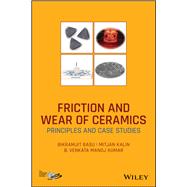This book covers the area of tribology broadly, providing important introductory chapters to fundamentals, processing, and applications of tribology. The book is designed primarily for easy and cohesive understanding for students and practicing scientists pursuing the area of tribology with focus on materials. This book helps students and practicing scientists alike understand that a comprehensive knowledge about the friction and wear properties of advanced materials is essential to further design and development of new materials.
The description of the wear micromechanisms of various materials will provide a strong background to the readers as how to design and develop new tribological materials. This book also places importance on the development of new ceramic composites in the context of tribological applications.
Some of the key features of the book include: Fundamentals section highlights the salient issues of ceramic processing and mechanical properties of important oxide and non-oxide ceramic systems; State of the art research findings on important ceramic composites are included and an understanding on the behavior of silicon carbide (SiC) based ceramic composites in dry sliding wear conditions is presented as a case study; Erosion wear behavior of ceramics, in which case studies on high temperature erosion behavior of SiC based composites and zirconium diboride (ZrB2) based composites is also covered; Wear behavior of ceramic coatings is rarely discussed in any tribology related books therefore a case study explaining the abrasion wear behavior of WC-Co coating is provided. Finally an appendix chapter is included in which a collection of several types of questions including multiple choice, short answer and long answer are provided.








